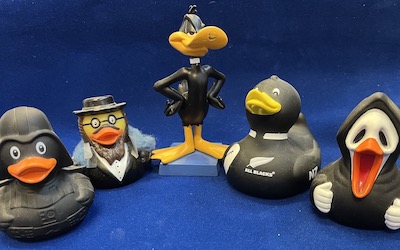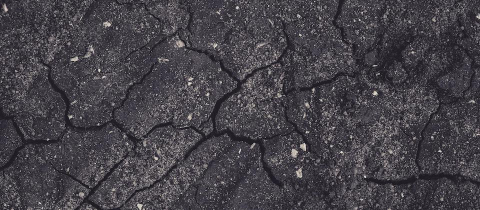I’m sitting here looking around my office for anything made of black plastic. The casing of my computer is in that category, so is my coffee machine, my printer, my cell phone stand, my stapler, a bunch of pens that clutter my desk, my electronic car key, an electric heater, a flower pot, the carbon atoms in my molecular models, the armrest on my chair and a garbage can as well as the garbage bag inside it. Even some of the ducks that adorn my shelves are made of black plastic! No, I am not bored or mentally disturbed. I’ve just come across a scientific publication that has piqued my curiosity. It is all about the downside of black plastics.

I have a long-standing interest in plastics and their fascinating chemistry. About fifty years ago (even as I write that number I have a hard time believing it) I put together a lecture I called “Miracle Materials” that focused on the history of plastics from the earliest synthetics like celluloid and Bakelite to the modern marvels of nylon and Lexan. Aside from noting that plastics were made from petroleum, a non-renewable resource, I made no mention of any drawbacks in the use of these substances. That’s because at the time there weren’t any. Or at least, there was no recognition of any in the scientific literature. There were only positives. Automobiles, airplanes, telephones, television sets, furniture and sporting equipment, all of which made life easier and more pleasurable, relied on plastics. We stored food in Tupperware containers, wore polyester leisure suits, gyrated with hula hoops and admired astronaut suits made of multiple layers of diverse plastics.
I have given that lecture just about every year since those early beginnings and I still describe the many benefits of plastics. The food, construction, electronics, transportation, cosmetic and health-care industries could not function without plastics. However, over the years, snags about the use of plastics began to creep into my lecture as research revealed that all was not rosy. There were thorns with which to contend. Studies that revealed some plastic components to be endocrine disruptors, concerns were raised about perfluoroalkyl substances (PFAS), the so-called “forever chemicals,” incorporated into some plastics because of their water and oil resistant properties, questions were being asked about the efficiency of recycling programs, and there were increasing concerns about plastic garbage ending up in the environment and presenting a danger to animal life.
Then we learned that the plastics that were thought to be indestructible were not so indestructible. At the mercy of waves, wind and sunlight, plastics can break down into microplastics that contaminate our food and water with potential health consequences. As a result, efforts are being made to curb the use of plastic bags, eliminate single use plastics, develop biodegradable alternatives, and ramp up recycling programs. And now, we will have to take a look at the widespread use of black plastics. Yet another nuance that will have to be included next time I give my lecture.
The “black” in plastics is due to the addition of carbon black, which is basically a form of soot produced by the incomplete combustion of coal, petroleum or vegetable matter. It is added to plastics as a reinforcing substance, the same reason for which it finds widespread use in tires. Another benefit is that carbon black absorbs ultraviolet radiation that can cause plastics to degrade. Now for the problems. Carbon black contains numerous compounds, some of which, like the polycyclic aromatic hydrocarbons (PAHs), have carcinogenic properties and have led the International Agency for Research on Cancer (IARC) to categorize carbon black as “possibly carcinogenic to humans.” Whether this is an issue in the containers used for many prepared foods, including those that are to be microwaved, is not clear, since the carbon black is locked within the matrix of the plastic and may not leach out in any significant amounts. Prepared food marketers like the black containers because they are cheap and are visually more appealing than their clear counterparts.
The biggest problem with black plastics seems to be the difficulty they pose in recycling. In theory, virtually all plastics can be recycled, but they require different technologies meaning that separation becomes critical. Modern recycling facilities are equipped with systems that shine infrared light on plastics and identify them by the specific wavelengths that are reflected. Carbon black absorbs infrared radiation and prevents the light from reaching the plastic. As a result, the specific polymers in black plastics cannot be identified which means that instead of being reconstituted into pellets for production of new goods they end up in landfill or the incinerator. This is not a small issue because black plastic makes up about 15% of all plastic waste.
Since companies know that most black plastic ends up in landfills, they are less likely to use plastics that are more expensive because they are recyclable. There is also less care about inclusion of substances that are not allowed in plastics that are destined to be recycled. For example, waste plastic from electronic equipment, such as computer casings, cannot be recycled into products that enter the marketplace because they contain potentially toxic flame retardants, heavy metals and antistatic agents. However, such electronic waste can be used to make products that end up in a landfill. Consequently, black plastic food containers may contain substances we don’t want ending up in our food. Producers switching to clear plastic containers that are more easily sorted, and are better candidates for entering the recycling stream, would be a step in the right direction.
It seems that the section in my lecture on plastics that deals with pitfalls gets longer every year. I’ve even added a question mark to the title. “Miracle Materials?” I’m now less inclined to buy prepared foods in black plastic containers, I try to stay away from single use plastic items, but I still retain my admiration for the large number of plastics that make our lives easier and more pleasurable. As far as my black duckies go, they are not going into any recycling bin anywhere. At least not while I’m still around.







